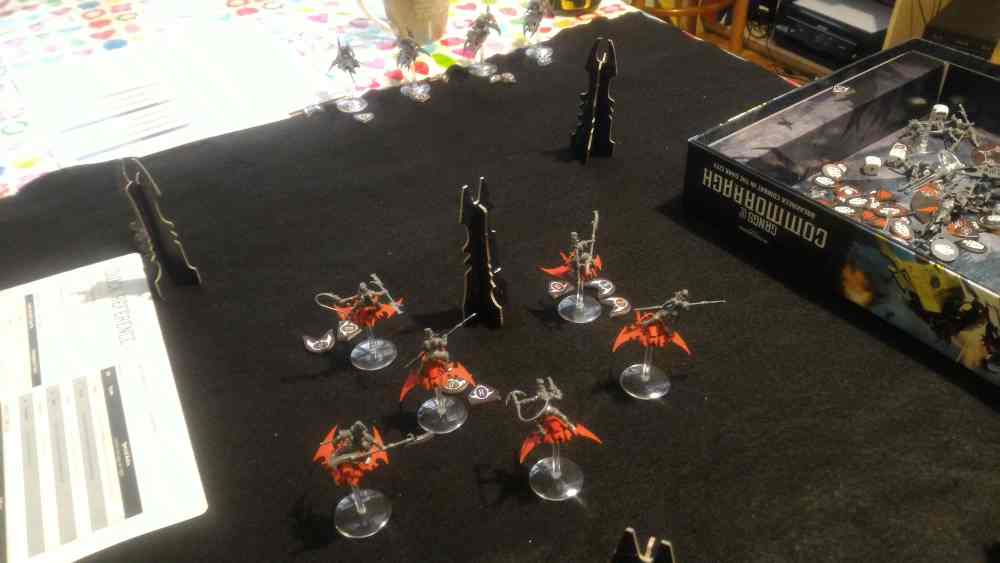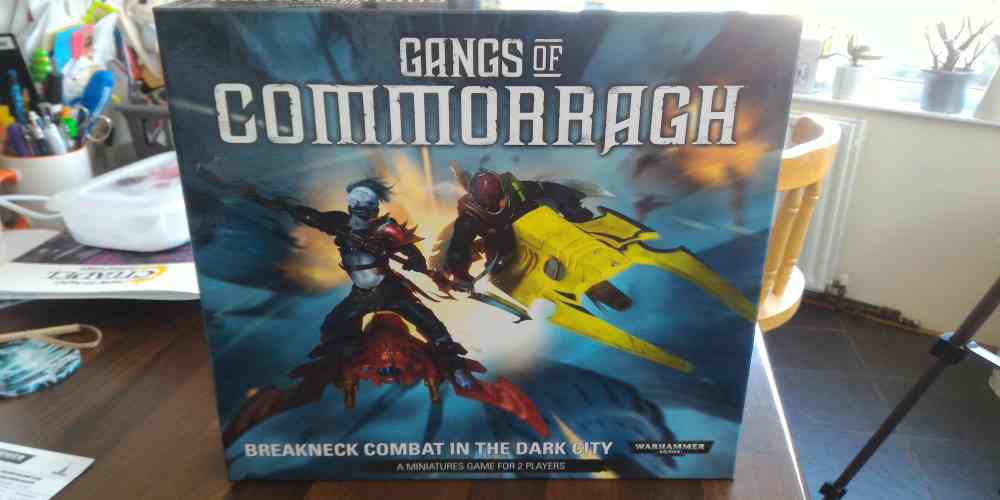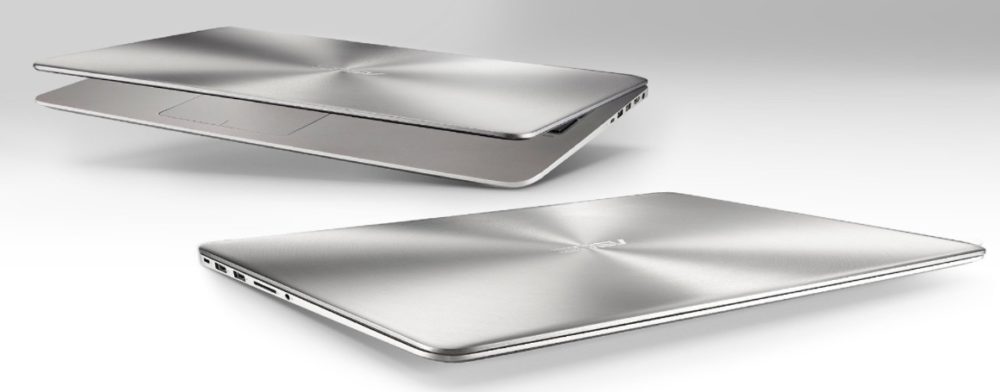Gangs of Commorragh is the latest small boxed game from Games Workshop. I previewed it here, with my unboxing video. In this post I’m going to dig a little deeper and find out how the game plays.
Overview:
"Do you bite your thumb at us, sir?" "I do bite my thumb, sir." "Do you bite your thumb at us, sir?" "No, sir, I do not bite my thumb at you, sir, but I bite my thumb, sir."
Gangs of Comorragh is a game for two players with games lasting around an hour. It depicts combat between two rival groups of Dark Eldar–the Gangs of Commorragh. Each gang (termed “murder pack”) is made up of four or more bikers who fly around a 3’X3′ board (minimum) and try to shoot one another out of the sky.
Games can be played as one-offs between two bands of warriors or as part of a narrative campaign, where gang members learn, progress, and rivalries intensify.
Components:
- 6 Dark Eldar Reaver miniatures
- 10 Dark Eldar Hellion miniatures
- Commorragh Terrain Pieces
- Rules
- Markers Counters and Dials
- Dice
- Getting Started Sheet
- 2 Reference Sheets
Preparation:
Like all Games Workshop games, a fair amount of preparation is required to play Gangs of Commorragh. In order to play, you have to assemble and preferably paint 16 airbikes and riders.
The instructions for this were, frankly, abysmal. The worst I’ve encountered from any GW game. If you had never picked up a Citadel Miniature before, I think you would have serious difficulty putting them together. The figures are particularly spindly and have many parts, making the task even harder. Make sure you have some sprue cutters before embarking on assembly.
My 11-year-old has assembled some of his own Citadel Miniatures, mainly Orks and Space Marines. He would have struggled with this set without help. He did, however, pick up the game quickly, so this is definitely a game you can play with pre-teens.

There is also the problem of whether paint before playing. If you follow any of the more serious painting forums on Facebook, you’ll discover that the community massively advocates painting model pieces before assembly. If not whilst completely disassembled then at least in “subassemblies” to make sure certain elements of a figure don’t stop you from painting another.
This makes a lot of sense. If a billowing cloak is going to restrict access to the armor beneath, paint the armor before attaching the cloak. Or, for Commorragh, if sticking the riders to the bikes is going to make the bikes difficult to paint, paint them separately and then stick them together afterward.
The problem with this is if, like me, you are slow at painting, it will be months before you can play the game. I find it a perennial problem with GW games, especially as the detailing on newer models is breathtakingly complex. In the end, I worked around the problem with a few blobs of sticky tack. Not the perfect solution as the riders often fell off, but a workable one.
Playing the Game:
The given complexity rating for Gangs of Comorragh is 1. At first, this seems to be a little optimistic, but after a few rounds, the game’s simplicity becomes apparent. The easiest way to play the game, and the way I would recommend on a first pass, is to use the standard gangs outlined in the rulebook.
There are two types of bike in the game. “Reavers,” which are similar to a Star Wars speeder bike, and “Hellions,” which are like the ultimate hoverboards upon which their riders stand. The former are more robust, whilst the latter are more nimble and easy to maneuver.
Set Up:

There is an initial setup phase, which involves alternately placing the six cardboard terrain pieces on the board. On the face of it, these are small and underwhelming, but they suit the game very well. In order for a good game of Commorragh, the building pieces need to have a small diameter to provide some cover but not become total barriers.
After that, you determine who sets up first, with the loser setting up in the middle of the board (with all bikes facing the same way). The other player then sets up along a random table edge. This is to simulate the ambush of one murder pack by the other. The chase is on!
A Game Turn: Fight! Fight! Fight!
Gangs of Comorragh, deviates from the Games Workshop norm in that players do not take turns to move all their models in play. Game rounds consist of players working alternately, moving one miniature at a time.

A note on vehicle arcs: Where miniatures are positioned, relative to one another, is a vital concept in Gangs of Commorragh. This is governed by “arcs”. Which arc a target or targeted model falls in determines how easy they are to hunt down and hit when shooting. Anybody familiar with X-Wing will understand this concept immediately.
Hunters and Quarries:
The first thing to do is determine which models are hunters and which are the quarries. For a model to be a hunter it must be within 18″ of an enemy model and have that model within its front arc. The hunter must also be within a prospective quarry’s rear arc.
Players take turns choosing a model to declare as a hunter. Any number of models can be hunters and a quarry can be hunted by more than one hunter. It is possible for a model to be hunter and quarry simultaneously but models can never hunt more than 1 enemy at a time. Hunter and quarry tokens are used to keep track of who is hunting whom. (This is similar to the locking tokens in X-Wing.) Any models that can’t be hunters are not declared.
Movement:
Players then take it in turns to move their models, rolling off to see who chooses to move first. (The rules are slightly unclear here. It states that the winner of the roll gets to move first, but moving first can be a disadvantage, so we have been playing it that the winner gets to choose who moves first.) Movement starts with a quarry model. The next movement is that quarry’s hunter. If that hunter is also a quarry, movement passes to that model’s hunter, and so on. This can set up what we called the “conga line of death.”
Once a chain of hunters and quarries has been resolved, the next player chooses a new quarry to move, possibly setting up a new conga line. Once all quarries and hunters have moved, all remaining models move, taking it turns, one at a time. If one player runs out of models, the other player moves all of his models in sequence.
All Models MUST move. Each bike has a minimum movement. Every bike may also make 1 turn (up to 45° or 60°, depending on the type of bike and measured by template) either at the beginning or the end of their movement. Models may also make a maneuver at any point during their move. This might be an extra turn or something special as outlined in the rules for each bike.
My favorite move is the Hellion rider’s hook turns. This allows them to use buildings to swing around 180° and end up moving back in the direction they came from. This turns out to be a pivotal move for Hellions that gives them a tactical edge over the Reavers.
In order to successfully make a maneuver, players must make a test against their bike’s agility. This test is fairly easy to pass for most bikes (in our game, the Hellions needed to roll under 10 with 2D6,) but as bikes take damage their agility decreases, making it more and more likely a crucial maneuver will be a failure.
Combat:
After all the movement and maneuvers have been carried out, it’s time for combat. Again, players roll off to see who chooses to fight first and models are chosen alternately by each player. Models may fight once, so the order in which you choose your models is significant.
There are a number of bonuses applied during combat, depending on the weapons used, the skill of the pilots, and the type of bike being fired on. The most significant modifiers come from relative positions of the bikes and whether they are hunter and quarry.
It is much easier to hit a bike moving in the same axis as you and harder to hit one moving across your path. Hitting your designated quarry is easier than hitting a different bike. The easiest shot to make in the game is when your quarry is directly ahead of you whilst you are in their rear arc.

To hit, you have to roll over the value of your opponent’s agility on 2D6, plus any modifiers you have. If you a score a hit you can roll for damage. Each weapon has a “kill” value. If you roll over this value on 2D6, you destroy the opponents bike. If you roll under, then the bike gains a damage counter. The next time a bike is hit, the number of damage counters it has sustained are added to the damage dice roll. So, the more hits a bike has taken the more likely it is to crash out. (Note: all attacks on Hellions get +1 to the damage roll due to them being more vulnerable than the Reavers.)
In a basic game there isn’t too much weapon choice, but in the full game, there are 13 weapons that can be fitted to your bikes, giving increased tactical possibilities. Each bike can have different combinations of weaponry. Some guns are more destructive but heavier, so they impede a bike’s handling. In the full campaign mode, weapons have to be bought and paid for, so every decision about armaments and the experience of your pilots becomes a trade off.
Washing up:
Once all the combat has been resolved, that is the end of the turn. With one exception.
If either side has lost a third or more of its strength, they must take a break test. Failure of the test means your murder-pack flees. It is possible for both teams to flee on the same turn, making for a dishonorable draw. In a campaign game, fleeing bikes are at no risk of being permanently destroyed, whereas bikes that have been shot down are. Therefore, if you are playing in a campaign, it might be better to voluntarily break rather than leave a lone biker to face overwhelming odds.
Assuming both players survive their break tests, a new game turn starts, with players rolling off to see who calls hunter and quarry first.
Play continues until either all of a player’s bikes are destroyed or until somebody fails a break test.
In a campaign game, there may be bonuses or penalties for winning/losing. Bikers will gain experience points with which they can buy upgrades and skills as they vie to make their murder-pack the most notorious in Commorragh.

The Verdict:
It seems to be a curse that miniatures games don’t make the best boardgames. GW make the best minis in town, but all its modern board games that I’ve played simply aren’t as good as my favorite board games that don’t have minis. Aesthetically, they are second to none, but it seems that using minis cuts down options for innovative mechanics and quality gameplay. This issue is not, by any means, exclusive to Games Workshop.
Gangs of Commorragh is in no way a bad game. It’s solid, it can be exciting, but it is not a brilliant game. It’s a little too fiddly for that. There are a lot of different bonuses and modifiers to remember to add. Unlike Lost Patrol, I don’t think I would pull this down to play with a friend. I have better games that take 60-90 mins to play. This is not an X-Wing beater. If I have longer, the Commoragh experience does not beat playing Age of Sigmar.
Having said that, it’s a great game for club night. If you have three hours, you can play two games. If you have a number of people signed up to the game, you can start to build up narratives of feuds between murder-packs: grudge matches and tit-for-tat ambushes. Maybe you could even weave star-crossed love into your stories.
If you’re modeling and converting is your thing, the figures are great, and the individual nature of the murder-pack members means the gangs are crying out for personalisation. My cursory review has not taken in the campaign aspects of the game, and they look solid. Especially if you can play with a consistent group over an extended period of time–hence great for a club night.
In that respect, Gangs of Commorragh is a neat little narrative skirmish game, one that will appeal to fans of the old Necromunda game. Like many Games Workshop games, the basic box is just the beginning. Where you take your game and your murder-pack is entirely up to you. Though I suggest leaving them at home when you visit the mall. Gangs of Commorragh is available on Amazon or direct from Games Workshop.
Disclaimer: I received a free copy of Gangs of Commorragh in exchange for an honest review.





Wow, I missed this one, although I’ve always loved the “specialist games” and the way the campaigns run to almost tell a story and give a more complete feel to individual models
…..free for an honest review? I’ll review every specialist game!